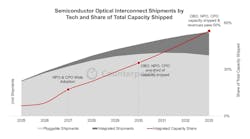Embedded optical modules to grow at a CAGR of 50% through 2033
OBO, CPO, and NPO solutions are projected to grow at a CAGR of 50% through 2033.
OBO, NPO and CPO — are now bringing massive improvements in transport capacity and especially processing for AI systems.
By 2033, over half of all revenues and capacity shipped will come from integrated semiconductor optical I/O solutions.
On-Board Optics (OBO), Near-Packaged Optics (NPO) and Co-Packaged Optics (CPO) are gaining momentum.
A new Counterpoint Research report forecasts that the shipments of OBO, CPO, and NPO solutions are projected to grow at a CAGR of 50% through 2033.
The research firm noted that while pluggable optical solutions have been around since 2016, integrated solutions — OBO, NPO and CPO — are now bringing massive improvements in transport capacity and especially processing for AI systems, delivering much higher bandwidth against far less power consumption and enabling the dense, high-bandwidth fabrics AI clustering requires to scale.
By enabling extensive bandwidth scaling, lower power consumption and AI supercomputing scaling, CPO will bring the most significant generational shift in AI computing.
Leo Liu, associate director for Counterpoint Research, likens the migration to going from ADSL to FTTH broadband but at the chip level.”
“All this additional speed and efficiency is going to usher in the next stage of AI computing,” he said, adding, “OBO was the first iteration, with products from companies like Applied Optoelectronics seeing wider adoption in 2023. But CPO is the big game-changer with virtually the entire transport layer being optical.”
A gradual path
Although NVIDIA, Intel, Marvell and Broadcom are driving CPO developments, the research firm said the evolutionary path will be gradual.
According to the Counterpoint report, by 2027, the broad adoption of NPO and CPO will help drive integrated revenue growth to triple digits year-over-year, while the share of capacity shipped in total will reach double digits.
Further, by 2033, over half of all revenues and capacity shipped will come from integrated semiconductor optical I/O solutions.
Copper to optics shift
With the advent of AI taking up more power in data centers, the shift away from copper to optical technologies will bring increased bandwidth with reduced power consumption.
“The shift towards ‘less copper, more optics’ means that as we move from OBO to NPO to CPO, far less copper is being used at each stage, resulting in non-linear performance improvements,” said Research Associate David Wu. Ultimately, we can expect to see an 80x generational leap in performance, with the 3D CPO likely to perform 80x better than current solutions.
For related articles, visit the Business Topic Center.
For more information on high-speed transmission systems and suppliers, visit the Lightwave Buyer’s Guide.
To stay abreast of fiber network deployments, subscribe to Lightwave’s Service Providers and Datacom/Data Center newsletters.
About the Author
Sean Buckley
Sean is responsible for establishing and executing the editorial strategy of Lightwave across its website, email newsletters, events, and other information products.


